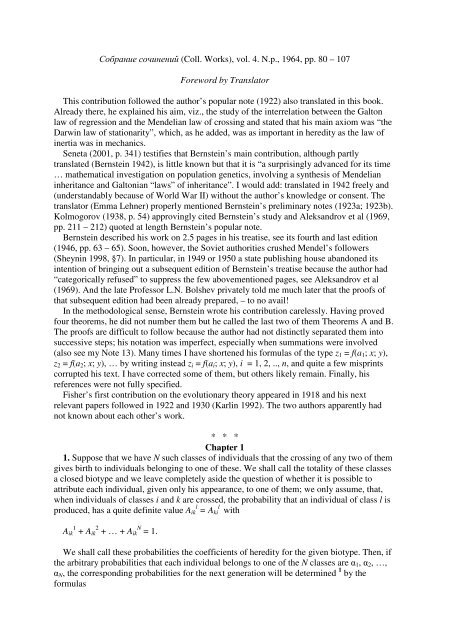kniga 7 - Probability and Statistics 1 - Sheynin, Oscar
kniga 7 - Probability and Statistics 1 - Sheynin, Oscar
kniga 7 - Probability and Statistics 1 - Sheynin, Oscar
You also want an ePaper? Increase the reach of your titles
YUMPU automatically turns print PDFs into web optimized ePapers that Google loves.
(Coll. Works), vol. 4. N.p., 1964, pp. 80 – 107Foreword by TranslatorThis contribution followed the author’s popular note (1922) also translated in this book.Already there, he explained his aim, viz., the study of the interrelation between the Galtonlaw of regression <strong>and</strong> the Mendelian law of crossing <strong>and</strong> stated that his main axiom was “theDarwin law of stationarity”, which, as he added, was as important in heredity as the law ofinertia was in mechanics.Seneta (2001, p. 341) testifies that Bernstein’s main contribution, although partlytranslated (Bernstein 1942), is little known but that it is “a surprisingly advanced for its time… mathematical investigation on population genetics, involving a synthesis of Mendelianinheritance <strong>and</strong> Galtonian “laws” of inheritance”. I would add: translated in 1942 freely <strong>and</strong>(underst<strong>and</strong>ably because of World War II) without the author’s knowledge or consent. Thetranslator (Emma Lehner) properly mentioned Bernstein’s preliminary notes (1923a; 1923b).Kolmogorov (1938, p. 54) approvingly cited Bernstein’s study <strong>and</strong> Aleks<strong>and</strong>rov et al (1969,pp. 211 – 212) quoted at length Bernstein’s popular note.Bernstein described his work on 2.5 pages in his treatise, see its fourth <strong>and</strong> last edition(1946, pp. 63 – 65). Soon, however, the Soviet authorities crushed Mendel’s followers(<strong>Sheynin</strong> 1998, §7). In particular, in 1949 or 1950 a state publishing house ab<strong>and</strong>oned itsintention of bringing out a subsequent edition of Bernstein’s treatise because the author had“categorically refused” to suppress the few abovementioned pages, see Aleks<strong>and</strong>rov et al(1969). And the late Professor L.N. Bolshev privately told me much later that the proofs ofthat subsequent edition had been already prepared, – to no avail!In the methodological sense, Bernstein wrote his contribution carelessly. Having provedfour theorems, he did not number them but he called the last two of them Theorems A <strong>and</strong> B.The proofs are difficult to follow because the author had not distinctly separated them intosuccessive steps; his notation was imperfect, especially when summations were involved(also see my Note 13). Many times I have shortened his formulas of the type z 1 = f(a 1 ; x; y),z 2 = f(a 2 ; x; y), … by writing instead z i = f(a i ; x; y), i = 1, 2, .., n, <strong>and</strong> quite a few misprintscorrupted his text. I have corrected some of them, but others likely remain. Finally, hisreferences were not fully specified.Fisher’s first contribution on the evolutionary theory appeared in 1918 <strong>and</strong> his nextrelevant papers followed in 1922 <strong>and</strong> 1930 (Karlin 1992). The two authors apparently hadnot known about each other’s work.* * *Chapter 11. Suppose that we have N such classes of individuals that the crossing of any two of themgives birth to individuals belonging to one of these. We shall call the totality of these classesa closed biotype <strong>and</strong> we leave completely aside the question of whether it is possible toattribute each individual, given only his appearance, to one of them; we only assume, that,when individuals of classes i <strong>and</strong> k are crossed, the probability that an individual of class l isproduced, has a quite definite value A ik l = A kilwithA ik 1 + A ik 2 + … + A ik N = 1.We shall call these probabilities the coefficients of heredity for the given biotype. Then, ifthe arbitrary probabilities that each individual belongs to one of the N classes are 1 , 2 , …, N , the corresponding probabilities for the next generation will be determined 1 by theformulas









